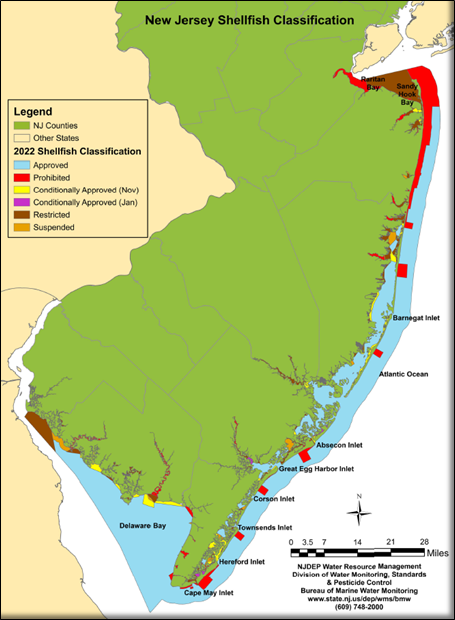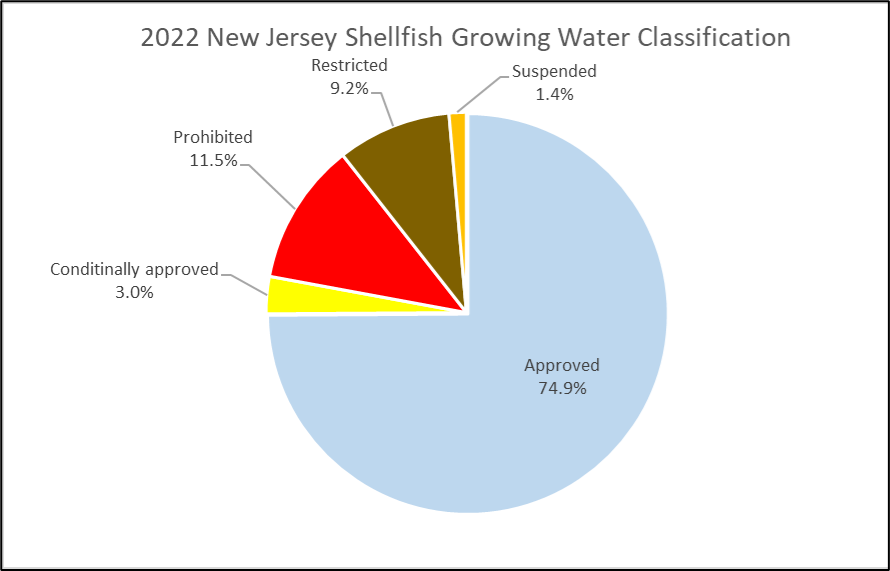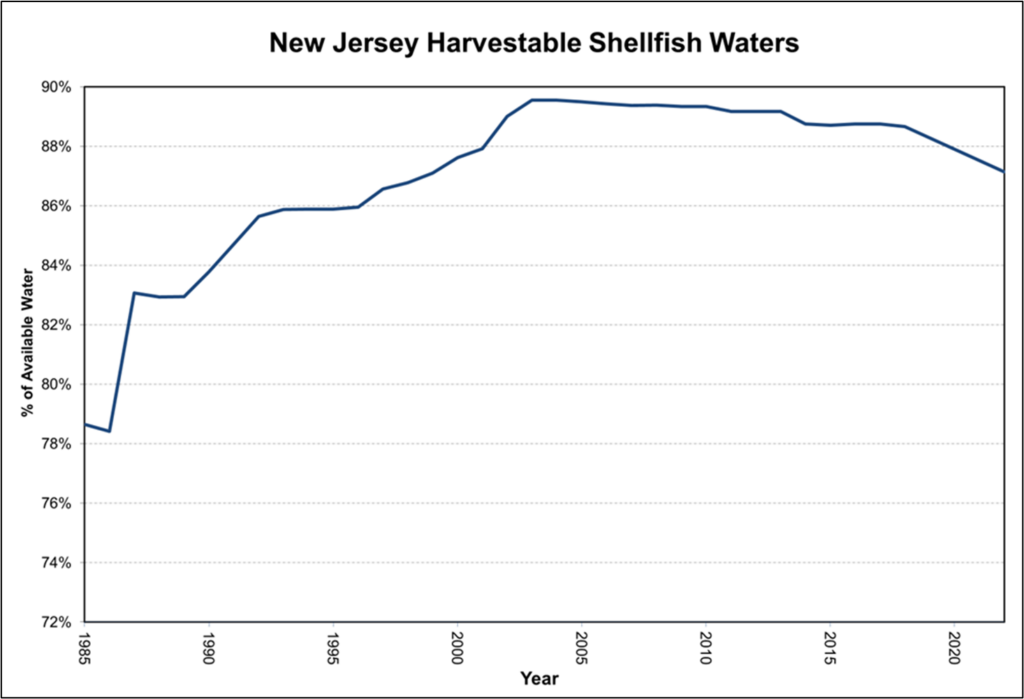In This Report:
Contact Us:
Environmental Trends Report
NJDEP, Division of Science and Research

Marine Water Pollution: Shellfish Waters
Background
The Division of Water Monitoring, Standards and Pesticide Control’s Bureau of Marine Water Monitoring (BMWM) collects and analyzes more than 10,000 marine water samples for pathogens every year. In addition, BMWM performs field surveys of coastal shorelines to monitor actual or potential pollution sources. This information is reviewed annually using National Shellfish Sanitation Program (NSSP) guidelines to update New Jersey’s shellfish growing water classifications.1
Shellfish are filter feeders. They pump water through their gills for both respiration and feeding. Shellfish gills filter out particulates in the pumping process, removing suspended material from the water. Because shellfish are such effective filter feeders, they can accumulate pollutants from surrounding waters.
If waters are polluted, contamination of shellfish can take place, therefore, shellfish growing waters must be properly monitored. Closures of shellfish growing waters are frequently due to bacterial contamination from a multitude of sources including wastewater discharges, marinas, boating activity, stormwater discharges, and runoff from agricultural lands.
New Jersey uses five basic classifications for shellfish waters: Approved, Conditionally Approved, Suspended, Restricted, and Prohibited. Each classification reflects a different degree of water quality based on bacteriological results derived from the analysis of fecal coliform data.
The 2022 shellfish classifications derived from water quality results are indicated in Figure 1. These waters are classified according to terms that are defined in the NSSP Guide for the Control of Molluscan Shellfish1. Each classification reflects a different degree of water quality based on fecal coliform data. Waters of exceptionally high quality are classified as Approved for harvest; sampling station data in these waters must meet the NSSP Approved criteria. Other waters that have this same high quality for a portion of the year are classified as Conditionally Approved (open for harvest from November through April or from January through April). Waters that do not meet the threshold for Approved or Conditionally Approved may be classified as Restricted if they meet the NSSP Restricted criteria. Shellfish in Restricted waters shall not be harvested except for depuration or relay pursuant to a permit issued by BMWM. Depuration is the process of moving shellfish to a controlled aquatic environment for a period of time in order to reduce the pathogenic organisms that may be present. No harvest is allowed in Prohibited waters; either these waters do not meet the NSSP criteria, or they are administratively closed due to the potential for water quality impacts (i.e., marina basins and lagoons). In addition, certain waters are classified as Prohibited because they are not sampled due to limited water depth, lack of shellfish habitat/shellfish product, or other environmental factors.

The delineations of the various shellfish growing water classifications are listed in regulation at N.J.A.C. 7:12. Pursuant to N.J.A.C. 7:12-1.4(a), BMWM shall immediately suspend harvest in areas impacted by an intermittent pollution episode or emergency condition when the event has or may have deleterious impact on public health. In addition, pursuant to N.J.A.C. 7:12-1.4(b), BMWM shall immediately suspend harvest in any waters that, at the time of sampling, do not meet the standards for the waters’ classification, pending the establishment by rulemaking of the appropriate classification and boundaries. Therefore, state shellfish growing waters may also be listed as Suspended.
The water quality data generated for shellfish water classifications is also used to determine the “Shellfish Harvest for Consumption Use” assessment in NJDEP’s Integrated Water Quality Assessment Report. For more information see: https://www.nj.gov/dep/wms/bears/assessment.htm.
Status and Trends
Figure 2 displays the percentage of state shellfish growing waters, by classification, for 2022. Approved, Conditionally Approved, and Restricted waters constitute “Harvestable” waters. Individually, the Approved, Conditionally Approved, and Restricted waters equate to 74.9%, 3%, and 9.2%, respectively; together these classifications represent more than 87% of New Jersey’s coastal waters. Presently, 1.4% of shellfish growing waters are Suspended, pending the establishment by rulemaking of the appropriate classification. The remaining 11.5% of the waters are not Harvestable and are classified as Prohibited.

Prohibited waters have often been affected by biological/chemical contamination associated with urban land/water use (e.g., runoff from impervious surfaces, damaged infrastructure, lagoons, and marina basin locations). Restricted and Conditionally Approved classifications are often used as buffers to limit shellfish harvest in waters abutting Prohibited areas, where inputs may be impacting water quality.

The considerable increase in Harvestable/Approved waters coming out of the latter part of the 1970’s was largely due to the advent and construction of larger, more efficient regional treatment facilities (Figure 3). Smaller, less efficient wastewater treatment facilities, often referred to as package plants, were replaced by larger regional facilities. Additionally, discharges from regional plants along State coastal waters were redirected to the ocean, where greater dilution prevailed, as opposed to shallow back bay or estuarine waters, where the smaller plants discharged. This in turn brought about improved water quality for the inner coastal waters of New Jersey. In addition, existing wastewater treatment facilities in the State underwent infrastructure upgrades and plant refurbishments that have provided better treatment and enhanced water quality.
Outlook and Implications
The majority of New Jersey’s coastal waters are classified as Approved (~75%), leading to the direct harvest and safe consumption of raw shellfish. There are pending upgrades awaiting the rule making process that will increase both the approved and harvestable waters, that are due to better storm water management and repairs/ upgrades to sanitary sewage infrastructure. In recent years, BMWM has concentrated considerable effort on stormwater input studies, associated fieldwork, and continually advanced chemical/microbiological studies. Such advances utilize more current methodologies for fieldwork and enhanced equipment for analysis of shellfish growing waters. BMWM continues to enhance field surveys and conduct non-point pollution source tracking studies; work with local, county, and state officials on maintaining and repairing infrastructure; and utilize advanced laboratory capabilities that will enable continual water quality enhancements for State shellfish growing waters.
More Information
Additional information can be obtained by contacting NJDEP’s Bureau of Marine Water Monitoring at (609) 748-2000 or by visiting https://www.nj.gov/dep/wms//bmw/.
References
1 United States Food and Drug Administration. (2019). National Shellfish Sanitation Program Guide for the Control of Molluscan Shellfish: 2019 Revision. http://www.fda.gov/Food/GuidanceRegulation/FederalStateFoodPrograms/ucm2006754.htm Accessed 8/30/2022.